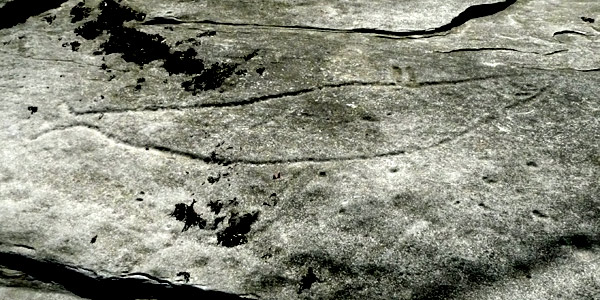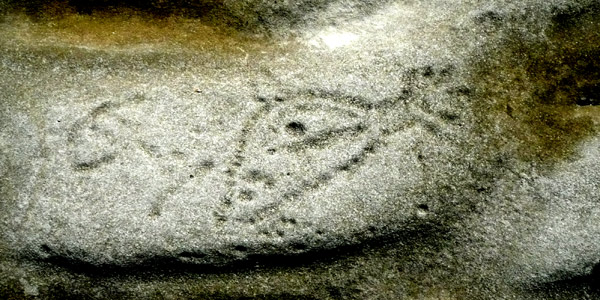revisiting Hornby’s petroglyphs


This year’s mini-vacation to Hornby Island was a sort of pilgrimage for me as we revisited some favourite spots from past visits. It must be over 15 years ago when we first saw the petroglyphs made by early First Nations peoples. Interestingly, those first photos were captured on film. They later appeared in several of my prints and in a book.
Sadly, the petroglyphs have worn down considerably since then for they are next to the sea and we could find only these two this time. The bright morning light meant the carvings appeared very faint in my digital photos so I’ve had to manipulate these images to bring out the contrast, hence the excessive graininess where the rocks were actually quite smooth. I’m so happy to have seen them again.
Related links:
my petroglyph photos in a book
a petroglyph photographed long ago
ADDENDUM November 10th: To answer Joe’s excellent question in the comments below, I’ve gone to the book mentioned in the link above: In Search of Ancient British Columbia, and the chapter on the Gulf Islands. On page 225, titled Petroglyphs, where my photographs are also featured, authors Philip Torrens and Heidi Henderson write:
Because petroglyphs are carved from rock rather than from bone or other organic matter, archaeologists cannot determine their ages using carbon-14 or other radioactive dating techniques. Attempts to determine ages by erosion are challenged by the fact that we have no way of knowing how deeply carved the grooves were in the first place. Given the heavy rain on most of the B.C. coast, it seems improbable that any surviving petroglyphs date back to the beginning of human presence here – at least 12,000 years ago. Estimates of their ages range from a few thousand years to less than a century, depending on the petroglyph and its location.
November 9, 2009 in Books, Canada and BC, Photoworks, Rock Art & Archaeology, Rocks by Marja-Leena
That’s a shame they are fading away. But at least you have photos of them.
I love these.
There is an area of Hawaiian petroglyphs near the current lava flow, not at present endangered. Next time I’m down there I might get some photos of them.
Cathy, that’s small consolation, yes…
Hattie, I’d love to see photos of your Hawaiian petroglyphs!
Ah, sad that they’ve worn away. How do things last so long and then fade away so quickly? Rising sea level? Anyway, glad they’re captured in your photos in that book. (Funny to see that I commented two years ago – I’d forgotten it. Speaking of things that fade fast!)
Any idea how old they are?
Leslee, unfortunately these petroglyphs are on relatively soft horizontal sandstone next to the sea, where they are subjected to winter’s high tides, stormy seas and heavy rainfalls. The eroding power of water is really quite awesome. (You have been a faithful commenter for a long time but surely none of us remember everything we’ve commented on!)
Joe, excellent question! I decided to answer it in the body of the post above.
You’re right that coastal winter storms really can be very intense. It was amazing to see the huge trees that had been tossed onto the shore on the western side of Vancouver Island.
The petroglyphs are a reminder for us that the people who lived on this continent before us understood that every step was sacred. They are teaching us still.
Susan, you’ve been to the west coast of Vancouver Island? Tofino area is our very favourite! Yes, the storms can be intense there, really make you feel small and helpless. The petroglyphs were/are considered sacred by these people, along with all of nature that sustained them. We sure need to learn those lessons, eh.
Oh, they really are fading fast. Sad. Have you incorporated them in your prints?
R, yes it’s sad. I’ve used the petroglyph images in some of my Paths and Nexus pieces, some links to them are in that second link in this post. Also many of the earlier Hornby rock photos appeared in the Metamorphosis pieces and later.
maybe you can present some of your work and your knowledge comparing the petroglyphs of BC with Finland for the Finn Forum?
ps. I spoke with one of the organizers about you and he said they are open to ideas about what /how to present. He asked me to tell you to email them with your idea.
I received a link to your site from my cousin, an artist in Montana, and have just begun exploring. I’d like to share with you photographs of desert petroglyphs found in my area of southern Nevada. The petroglyphs are primarily surface carved into the dark “desert varnish” that appears on the rocks. Please let me know if you are interested, and if so, where to mail or email them.
Kiitos paljon –
Hi Loretta! Oh, yes, I’m very interested! How very kind of you, I’d love to see your photos. Will email you separately. Kiitos!